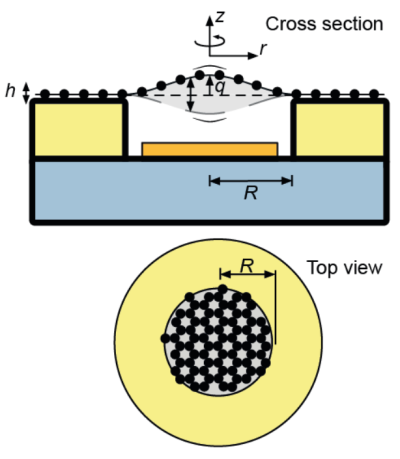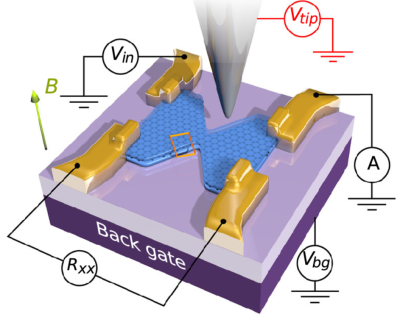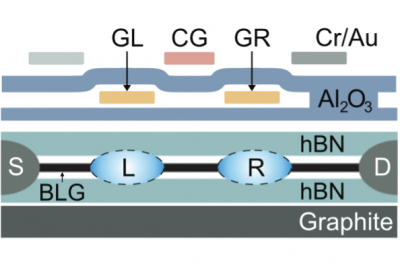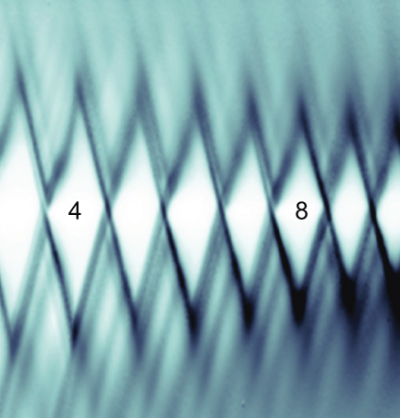Current events
Next talk tomorrow at 11:00 by Mrityunjay Pandey!
News 06.06.2025
New publication:Anisotropic supercurrent suppression and revivals in a graphene-based Josephson junction under in-plane magnetic fields
Site Content:
12.08.2021
New publication: Dynamics of 2D material membranes

2D Materials 8, 042001 (2021) The dynamics of suspended two-dimensional (2D) materials has received increasing attention during the last decade, yielding new techniques to study and interpret the physics that governs the motion of atomically thin layers. This has led to insights into the role of thermodynamic and nonlinear effects as well as the mechanisms that govern dissipation and stiffness in these resonators. In this review, we present the current state-of-the-art in the experimental study of the dynamics of 2D membranes. The focus will be both on the experimental measurement techniques and on the interpretation of the physical phenomena exhibited by atomically thin membranes in the linear and nonlinear regimes. We will show that resonant 2D membranes have emerged both as sensitive probes of condensed matter physics in ultrathin layers, and as sensitive elements to monitor small external forces or other changes in the environment. New directions for utilizing suspended 2D membranes for material characterization, thermal transport, and gas interactions will be discussed and we conclude by outlining the challenges and opportunities in this upcoming field.

12.07.2021
New publication: Upstream modes and antidots poison graphene quantum Hall effect

Nat. Commun.12, 4265 (2021) The quantum Hall effect is the seminal example of topological protection, as charge carriers are transmitted through one-dimensional edge channels where backscattering is prohibited. Graphene has made its marks as an exceptional platform to reveal new facets of this remarkable property. However, in conventional Hall bar geometries, topological protection of graphene edge channels is found regrettably less robust than in high mobility semi-conductors. Here, we explore graphene quantum Hall regime at the local scale, using a scanning gate microscope. We reveal the detrimental influence of antidots along the graphene edges, mediating backscattering towards upstream edge channels, hence triggering topological breakdown. Combined with simulations, our experimental results provide further insights into graphene quantum Hall channels vulnerability. In turn, this may ease future developments towards precise manipulation of topologically protected edge channels hosted in various types of two-dimensional crystals.

01.06.2021
Christoph Stampfer becomes member of the Steering Committee of the profile area MatSE
Christoph Stampfer is appointed to the Steering Committee of the MatSE (Material science and engineering) profile area at RWTH Aachen University.

26.05.2021
New publication: Tunable coupling of two mechanical resonators by a graphene membrane

2D Materials 8, 035039(2021) Coupled nanomechanical resonators are interesting for both fundamental studies and practical applications as they offer rich and tunable oscillation dynamics. At present, the mechanical coupling in such systems is often mediated by a fixed geometry, such as a joint clamping point of the resonators or a displacement-dependent force. Here we show a graphene-integrated electromechanical system consisting of two physically separated mechanical resonators—a hybrid graphene comb-drive actuator system and a suspended silicon beam—that are tunably coupled by the integrated graphene membrane. The graphene membrane, moreover, provides a sensitive electrical read-out for the two resonating systems showing 16 different modes in the frequency range from 0.4 to 24 MHz. In addition, by pulling on the graphene membrane with an electrostatic potential applied to silicon beam resonator, we control the mechanical coupling, quantified by the g-factor, from 20 kHz to 100 kHz. Our results pave the way for coupled nanoelectromechanical systems requiring controllable mechanically coupled resonators.

14.04.2021
New publication: Electrical Control over Phonon Polarization in Strained Graphene

Nano Lett. 21, 2898 (2021) We explore the tunability of the phonon polarization in suspended uniaxially strained graphene by magneto-phonon resonances. The uniaxial strain lifts the degeneracy of the LO and TO phonons, yielding two cross-linearly polarized phonon modes and a splitting of the Raman G peak. We utilize the strong electron–phonon coupling in graphene and the off-resonant coupling to a magneto-phonon resonance to induce a gate-tunable circular phonon dichroism. This, together with the strain-induced splitting of the G peak, allows us to controllably tune the two linearly polarized G mode phonons into circular phonon modes. We are able to achieve a circular phonon polarization of up to 40% purely by electrostatic fields and can reverse its sign by tuning from electron to hole doping. This provides unprecedented electrostatic control over the angular momentum of phonons, which paves the way toward phononic applications.

09.03.2021
New publication: How to solve problems in micro- and nanofabrication caused by the emission of electrons and charged metal atoms during e-beam evaporation

J. Phys. D: Appl. Phys. 54, 225304 (2021) We discuss how the emission of electrons and ions during electron-beam-induced physical vapor deposition can cause problems in micro- and nanofabrication processes. After giving a short overview of different types of radiation emitted from an electron-beam (e-beam) evaporator and how the amount of radiation depends on different deposition parameters and conditions, we highlight two phenomena in more detail: First, we discuss an unintentional shadow evaporation beneath the undercut of a resist layer caused by the one part of the metal vapor which got ionized by electron-impact ionization. These ions first lead to an unintentional build-up of charges on the sample, which in turn results in an electrostatic deflection of subsequently incoming ionized metal atoms toward the undercut of the resist. Second, we show how low-energy secondary electrons during the metallization process can cause cross-linking, blisters, and bubbles in the respective resist layer used for defining micro- and nanostructures in an e-beam lithography process. After the metal deposition, the cross-linked resist may lead to significant problems in the lift-off process and causes leftover residues on the device. We provide a troubleshooting guide on how to minimize these effects, which e.g. includes the correct alignment of the e-beam, the avoidance of contaminations in the crucible and, most importantly, the installation of deflector electrodes within the evaporation chamber.

08.03.2021
New publication: Tunable interdot coupling in few-electron bilayer graphene double quantum dots

Appl. Phys. Lett. 118, 103101 (2021) We present a highly controllable double quantum dot device based on bilayer graphene. Using a device architecture of interdigitated gate fingers, we can control the interdot tunnel coupling between 1 and 4 GHz and the mutual capacitive coupling between 0.2 and 0.6 meV, independent of the charge occupation of the quantum dots. The charging energy and, hence, the dot size remain nearly unchanged. The tuning range of the tunnel coupling covers the operating regime of typical silicon and GaAs spin qubit devices.

05.03.2021
New publication: Dispersive sensing of charge states in a bilayer graphene quantum dot

Appl. Phys. Lett. 118, 093104 (2021) We demonstrate dispersive readout of individual charge states in a gate-defined few-electron quantum dot in bilayer graphene. We employ a radio frequency reflectometry circuit, where an LC resonator with a resonance frequency close to 280 MHz is directly coupled to an Ohmic contact of the quantum dot device. The detection scheme based on changes in the quantum capacitance operates over a wide gate-voltage range and allows us to probe excited states down to the single-electron regime. Crucially, the presented sensing technique avoids the use of an additional, capacitively coupled quantum device such as a quantum point contact or single electron transistor, making dispersive sensing particularly interesting for gate-defined graphene quantum dots.

